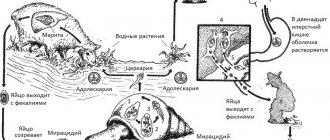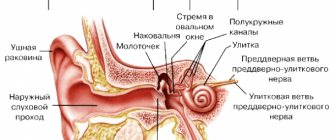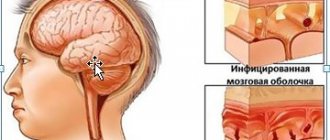Pituitary microadenoma is a small neoplasm that forms on the internal tissues of the organ. The size of this type of benign tumor does not exceed one centimeter. Since the compaction has virtually no effect on a person’s well-being, it is difficult to diagnose. In cases where it affects the production of hormones, characteristic symptoms are present.
Since the compaction practically does not manifest itself at all, it is difficult to diagnose.
Causes
One of the main causes of microadenoma of the pituitary gland of the brain is a change in hormonal levels. Most often this happens during pregnancy and breastfeeding. In addition, the following reasons can provoke deformation of gland tissue:
Use of oral contraceptives.
- disruptions in the activity of an internal organ associated with the hypothalamus;
- the hormonal function of the peripheral glands decreases, which provokes increased tissue growth and the appearance of compaction;
- hereditary factor;
- artificial termination of pregnancy and other surgical interventions in the pelvic organs;
- use of oral hormonal contraception;
- mechanical shocks, injuries that affect the nervous system;
- infectious processes in the brain;
- bad habits of a woman during pregnancy, as well as the ingestion of toxic substances into the body. This negatively affects the development of the embryo.
Pituitary microadenoma: treatment with traditional medicine
Experts do not recommend treating pituitary microadenoma with folk remedies. Widely advertised infusions of medicinal herbs do not bring the desired effect, but, on the contrary, can aggravate the condition of the thyroid gland and adrenal glands.
Prolactinoma is very susceptible to drug treatment. Endocrinologists most often use two types of drugs: bromocretin or cabergoline. As a result of long-term medication use, a benign neoplasm significantly decreases in size or disappears completely.
Therapy with such drugs is carried out for two years, they have a number of side effects and are sold strictly according to a doctor’s prescription.
Herbal infusions in pregnant women suffering from microtumor of the pituitary gland can cause miscarriage.
By refusing adequate drug therapy, the patient loses valuable time and risks his life.
It is believed that folk recipes for decoctions are completely safe. But in this case there are a number of caveats:
- it is difficult to calculate the dosage prescribed individually for each patient
- there is no control over the effect produced
- the plants used are very poisonous and can cause irreparable damage to health.
It will not be possible to normalize hormonal levels with the help of grandmother’s decoctions. Do not forget the fact that the tumor, although slowly, progresses in a closed space. Any form of tumor can change its nature to malignant. Being carried away by traditional methods, a person can pay dearly for such treatment.
Signs
The symptoms of a pituitary microadenoma depend on whether it affects the hormonal balance in the body. Signs will be different in men and women due to the characteristics of endocrine activity.
If the lump is hormonally inactive, it is difficult to diagnose. There are no changes in the endocrine system, so a small tumor does not cause characteristic symptoms. Hormonally active neoplasms provoke serious changes due to hormonal imbalance.
Common symptoms in women include:
Gaining excess weight.
- gaining excess weight;
- the appearance of breast milk even in the absence of lactation;
- inability to become pregnant due to suppression of ovarian activity;
- disruptions of the menstrual cycle.
In males, the increased secretion of prolactin is not so obvious, although the symptoms will be similar. Men usually don't take their own weight so seriously, so they may ignore increasing it. There are also problems with potency.
If the adenoma is located on tissues that are responsible for the production of thyroid-stimulating hormone, then the symptoms will be different. Patients note the occurrence of nodular goiter on the thyroid gland, sudden weight loss, mood swings, tachycardia and other cardiac disorders.
Heart disorders.
With increased production of growth hormone, excessive growth of all tissues occurs. In children, this manifests itself in gigantism, disturbances in the functioning of internal organs (gastrointestinal tract, lungs, internal genital organs, etc.). If an adult has a microadenoma of this type, a disproportionate increase in the size of individual parts of the body is noted. The voice becomes rougher, diabetes insipidus occurs, and there is an increased risk of developing cancer.
Common symptoms include diabetes.
The next type of compaction (corticotropic microadenoma) affects the adrenal glands, causing an increase in their work. This manifests itself in increased body weight. However, weight gain occurs unevenly. Fat is deposited mainly in the neck, abdomen, and thighs. Stretch marks occur due to a rapid increase in mass, and there is more hair on the body (this is especially noticeable in women). Common symptoms include diabetes and mental disorders.
If the tumor contributes to the excessive production of gonadotropic hormones, then it causes sexual dysfunction. This leads to infertility, impotence, and a high risk of malignant neoplasms.
As the size of the microadenoma increases, the symptoms will worsen. In addition to hormonal disorders, migraines, dizziness and loss of consciousness, and blurred vision will appear.
Pituitary microadenoma: symptoms
As a rule, the disease does not manifest itself and its detection is random.
Depending on the type of hormone produced, a microadenoma may exhibit the following symptoms:
- Somatotropic tumor. Promotes the development of excessive growth in children and a rare disease in adults - acromegaly (the voice becomes rougher, the fingers increase in diameter, the hands and feet grow)
- Prolactinoma. The most common type of microadenoma. A woman’s menstrual cycle is disrupted, the desire for intimacy decreases, and discharge from the breast appears. Males are likely to have sexual dysfunction.
- Microadenoma, which produces corticotropic hormones, provokes the appearance of Itsenko-Cushing's disease, which is characterized by abnormal redistribution of adipose tissue, the appearance of purple stripes on the skin, and changes in the patient's mental state.
- Gonadotropic tumor of the pituitary gland - can cause uterine bleeding in women, and in men there is likely to be a pathological increase in the size of the mammary glands
- Thyrotropic microadenoma is the rarest tumor; its appearance leads to thyrotoxicosis.
In addition to specific symptoms, doctors identified general signs of the disease for all types of tumor lesions:
- changes in vision for the worse associated with optic nerve atrophy
- severe headache located in the eye area that does not respond to painkillers
If such signs are detected, you should immediately seek help from an endocrinologist.
An advanced stage of microadenoma will lead to its transformation into a larger adenoma, which will lead to a deterioration in the general condition.
Dangerous consequences
If pathology is identified, there is a chance of avoiding complications. The disease cannot be ignored, since microadenoma of the pituitary gland of the head tends to increase in size. As it grows, major changes occur in hormonal activity. Large tumors put pressure on surrounding tissues, negatively affecting the processes occurring in the central nervous system.
Hormonally active tumors can provoke irreversible processes. Excessive production of hormones causes diabetes and cardiovascular disorders. The seal poses a threat not only to the health, but also to the life of the patient if left untreated.
Over time, vision becomes impaired and brain tissue may be damaged. In addition, the pathology causes infertility due to hormonal imbalance.
Types of glandular tumors of the pituitary gland
Hormonally active microadenomas are named depending on what hormone they synthesize:
- prolactinoma is a tumor that synthesizes prolactin, a hormone responsible for the production of breast milk in a nursing woman;
- somatotropinoma – produces growth hormone;
- gonadotropinoma – regulates the production of sex hormones;
- corticotropinoma – it contains the synthesis of corticosteroid hormones;
- thyrotropinoma of the pituitary gland - synthesizes substances that control the functioning of the thyroid gland.
Microadenoma during pregnancy
This type of cystic formation often appears in young women planning pregnancy. Doctors recommend not planning to conceive until the problem is resolved. This is due to unstable hormonal levels and a high risk of miscarriage. If conception becomes known before planning and treatment, the patient is prescribed medications that suppress excess hormone production.
A pregnant woman should be checked regularly.
For some types of thickening, it is recommended to refrain from planning a child for a period of one year or more. If the adenoma is inactive, pregnancy is not prohibited. A woman will need to monitor her hormonal balance and regularly monitor the dynamics of changes.
Microadenoma suggests refusal of breastfeeding. Lactation can provoke increased tissue growth, so you need to feed the newborn with specialized formulas.
Why does microadenoma appear?
A neoplasm of the pituitary gland appears due to excessively active growth of individual cells. Dividing, they form a gradually increasing focus of hypertrophy.
During certain periods of a person’s life, the work of the pituitary gland is especially intense. The function increases during pregnancy, childbirth, breastfeeding, after injury and in moments of physical and psychological stress. At this time, the gland secretes more hormones and is in constant functional tension. It is during such periods that the largest number of newly emerging pituitary microadenomas is recorded.
How is it diagnosed?
This type of adenoma is difficult to identify unless it belongs to the hormonally active variety. In this case, there are no symptoms; the small size of the thickening will not allow it to be diagnosed during a routine examination. If the patient suspects that he has a benign tumor, he consults a doctor for a diagnosis.
Based on complaints, the doctor will prescribe the following types of examinations:
Magnetic resonance imaging.
- Magnetic resonance or computed tomography are the most effective diagnostic methods. They allow you to get the full picture. The pituitary gland is visualized and any changes that occur in its parts are noted. During the study, the dimensions of the capsule are specified. Ultrasound and x-ray are ineffective in the case of microadenoma;
- biochemical examination of blood and urine. The level of hormones is determined, their deficiency or excess is monitored. The advantage of the analysis is that it allows you to identify disorders at an early stage of tumor development;
- undergo an examination by an ophthalmologist to determine visual impairment.
Pituitary microadenoma: treatment
An endocrinologist must correctly diagnose a pituitary tumor.
The following analysis techniques are mainly used:
- initial examination of the patient, examination of complaints
- examination by an ophthalmologist
- hormone analysis to determine the type of adenoma
- X-ray of the skull, in particular the area of the sella turcica
- computed tomography of the brain
- Brain MRI allows detailed examination of the tumor site
If a non-hormonal adenoma is diagnosed, only medical supervision and observation is recommended. Once a year, the patient is required to undergo a computer scan of the brain, take hormonal tests and undergo a consultation with an endocrinologist.
Hormone-active microadenomas require more active therapy. Here again, attention is paid to the hormone produced by the tumor.
Treatment methods include:
- stabilizing the level of hormones produced by the pituitary gland
- radiation therapy for some forms of pituitary microtumor
- when the glandular tissue of the lesion grows, surgical intervention is recommended
Apart from prolactinoma, other forms of microadenoma are practically unaffected by pharmaceuticals. Then surgical intervention is prescribed, although doctors try to use wait-and-see tactics for as long as possible.
The traditional method of removing tumors is through craniotomy or through the patient's nasal passages.
Doctors resort to trepanation as a last resort if the microadenoma is developing too actively. Operation through transnasal ducts is well tolerated by most patients, however, some complications in the form of bleeding and the appearance of infectious and inflammatory processes are also possible here.
Radiosurgery copes well with microadenomas of different diameters. It is used for all types of tumors. Using a gamma knife, radioactive substances are injected into the tumor, as a result of which the controlled size of the microadenoma is established and the endocrine functions of the pituitary gland are restored. The patient gets rid of the prospect of taking hormonal pills for life.
Whatever method of treatment the doctor prescribes, it is much more effective than no therapy as such.
Further forecast
The prognosis for recovery from microadenoma is in most cases positive. This is due to its small size. The compaction usually responds well to various types of treatment and eliminates relapses. If it grows in size, it will be much more difficult to remove.
When diagnosing a small tumor, the doctor may not prescribe intervention or conservative treatment. The patient will only need to monitor changes in its size and regularly come for examination. In some cases, the tumor does not grow during a person’s life, and therefore does not affect its quality.
Prevention
This is a poorly studied type of cystic formation, so there are few specific preventive measures. You can reduce the risk of developing pathology if you follow several rules:
- if a hormonal imbalance is detected, then it is necessary to find out its cause and eliminate it;
- if any infectious diseases that affect brain tissue are detected, they must be treated under medical supervision;
- if any of the symptoms are present, you should urgently consult a doctor;
- When making an accurate diagnosis, you must adhere to the treatment methods prescribed by the attending physician.
Pituitary microadenoma usually does not pose a serious threat to human life. But as its size increases, it provokes pathological changes that require a quick response. Therefore, its symptoms cannot be ignored.











